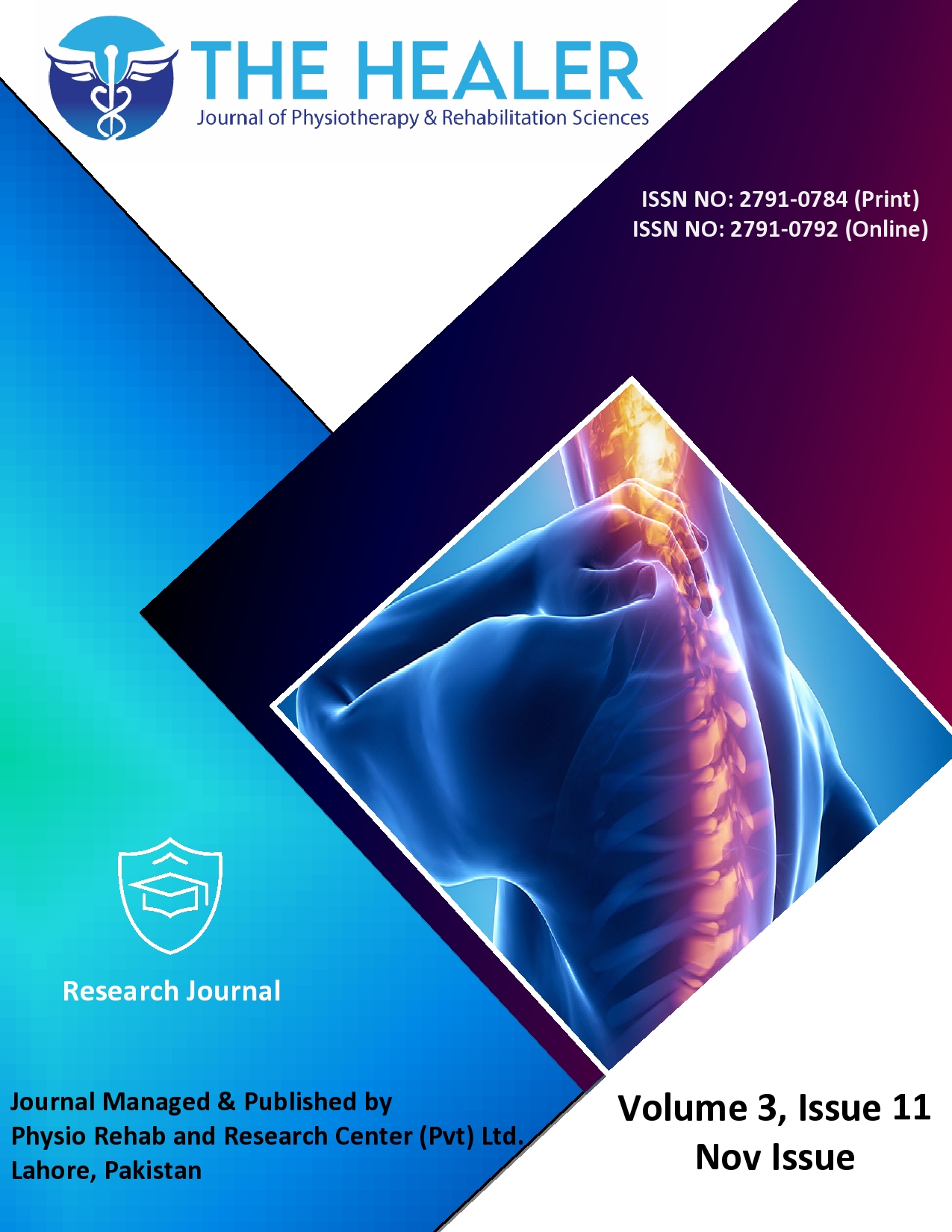Effects of Whole-Body Vibration versus Pilates Exercise on Bone Mineral Density among Geriatric Population
Whole-Body Vibration vs Pilates Exercise in Geriatric Population
DOI:
https://doi.org/10.55735/hjprs.v3i11.288Keywords:
Bone Mineral Density , Exercises, Geriatric Population, Whole-body VibrationAbstract
Background: Impact exercises can help control the prevalent issue of decreased bone mineral density in older persons. Whole-body vibration and muscle-strengthening workouts are two of the activities that have been researched. Objective: This study aimed to compare the effects of Whole-body vibration and Pilates exercises on bone mineral density in the elderly. Methodology: In this study, 38 elder adults were randomly assigned to one of two groups: Pilates (n = 19) or vibration (n = 19). Areal bone mineral density was measured by dual-energy x-ray absorptiometry at baseline and follow-up for the lumbar spine, femoral neck, whole hip, trochanter, intertrochanter, and ward area. The intervention took place three times a week for twelve weeks, for a total of thirty-six sessions. The duration of this study was from March 2024 to October 2024 and analysis of data was done using SPSS version 25. The categorical data was presented as frequency and percentages and quantitative using mean and standard deviations. Results: The within-group analysis revealed significant improvements in areal bone mineral density values across both groups, with the vibration group showing greater increases compared to the Pilates group in all measured areas (p<0.05). The between-group analysis confirmed that the vibration group achieved significantly higher bone mineral density gains than the Pilates group, particularly in the lumbar spine and trochanter regions (p<0.01). Effect sizes (Cohen’s d) indicate strong practical significance, with values over 1.0 in several areas suggesting a substantial impact of vibration therapy on bone density improvement among older adults. Overall, vibration therapy was more effective than Pilates in enhancing bone mineral density. Conclusion: Both whole-body vibration and Pilates exercises had a comparable impact on bone mineral density in older people, however, whole-body vibration's effects were more noticeable.
Downloads
References
Dolny DG, Reyes GFC. Whole body vibration exercise: training and benefits. Current Sports Medicine Reports 2008; 7(3): 152-7.
Nordlund M, Thorstensson A. Strength training effects of whole‐body vibration? Scandinavian Journal of Medicine & Science in Sports 2007; 17(1): 12-7.
Edwards M, Dennison E, Sayer AA, Fielding R, Cooper C. Osteoporosis and sarcopenia in older age. Bone 2015; 80: 126-30.
Tarantino U, Baldi J, Celi M, et al. Osteoporosis and sarcopenia: the connections. Aging Clinical and Experimental Research 2013; 25: 93-5.
Kim SK. Identification of 613 new loci associated with heel bone mineral density and a polygenic risk score for bone mineral density, osteoporosis and fracture. PloS one 2018; 13(7): e0200785.
Binesh M, Ehsani F, Motaharinezhad F, Jayedi A, Emadi A. The effect of whole-body vibration on glucose and lipid profiles in type-2 diabetes: a systematic review and pairwise and network meta-analyses of randomized trials. Scientific Reports 2024; 14(1): 12494.
Kelley GA, Kelley KS, Tran ZV. Exercise and lumbar spine bone mineral density in postmenopausal women: a meta-analysis of individual patient data. The Journals of Gerontology Series A: Biological Sciences and Medical Sciences 2002; 57(9): M599-M604.
Bernardo LM. The effectiveness of Pilates training in healthy adults: An appraisal of the research literature. Journal of Bodywork and Movement Therapies 2007; 11(2): 106-10.
Bayram KS, Şahin G, Zateri C, Coşkun A. Effect of short-term Pilates exercises on bone mineral density and physical performance in older women. Spor Hekimliği Dergisi 2023; 58(2): 088-93.
Fernández-Rodríguez R, Alvarez-Bueno C, Reina-Gutiérrez S, Torres-Costoso A, Nunez de Arenas-Arroyo S, Martínez-Vizcaíno V. Effectiveness of Pilates and Yoga to improve bone density in adult women: A systematic review and meta-analysis. PloS One 2021; 16(5): e0251391.
Gandolfi NRS, Corrente JE, De Vitta A, Gollino L, Mazeto GMFdS. The influence of the Pilates method on quality of life and bone remodelling in older women: a controlled study. Quality of Life Research 2020; 29: 381-9.
Jassal SK, Von Muhlen D, Barrett‐Connor E. Measures of renal function, BMD, bone loss, and osteoporotic fracture in older adults: the Rancho Bernardo study. Journal of Bone and Mineral Research 2007; 22(2): 203-10.
Küçükçakır N, Altan L, Korkmaz N. Effects of Pilates exercises on pain, functional status and quality of life in women with postmenopausal osteoporosis. Journal of Bodywork and Movement Therapies 2013; 17(2): 204-11.
Tang BM, Eslick GD, Nowson C, Smith C, Bensoussan A. Use of calcium or calcium in combination with vitamin D supplementation to prevent fractures and bone loss in people aged 50 years and older: a meta-analysis. The Lancet 2007; 370(9588): 657-66.
Johnell O, Kanis JA, Oden A, et al. Predictive value of BMD for hip and other fractures. Journal of Bone and Mineral Research 2005; 20(7): 1185-94.
Li H-L, Shen Y, Tan L-H, et al. Relationship between bone mineral density and fragility fracture risk: a case-control study in Changsha, China. BMC Musculoskeletal Disorders 2021; 22: 1-8.
Kiel DP, Hannan MT, Barton BA, et al. Low‐magnitude mechanical stimulation to improve bone density in persons of advanced age: a randomized, placebo‐controlled trial. Journal of Bone and Mineral Research 2015; 30(7): 1319-28.
Weber DR, Boyce A, Gordon C, et al. The utility of DXA assessment at the forearm, proximal femur, and lateral distal femur, and vertebral fracture assessment in the pediatric population: 2019 ISCD official position. Journal of Clinical Densitometry 2019; 22(4): 567-89.
Gusi N, Raimundo A, Leal A. Low-frequency vibratory exercise reduces the risk of bone fracture more than walking: a randomized controlled trial. BMC Musculoskeletal Disorders 2006; 7: 1-8.
Kelley GA, Kelley KS, Tran ZV. Exercise and bone mineral density in men: a meta-analysis. Journal of Applied Physiology 2000; 88(5): 1730-6.

Downloads
Published
License
Copyright (c) 2024 The Healer Journal of Physiotherapy and Rehabilitation Sciences

This work is licensed under a Creative Commons Attribution 4.0 International License.














